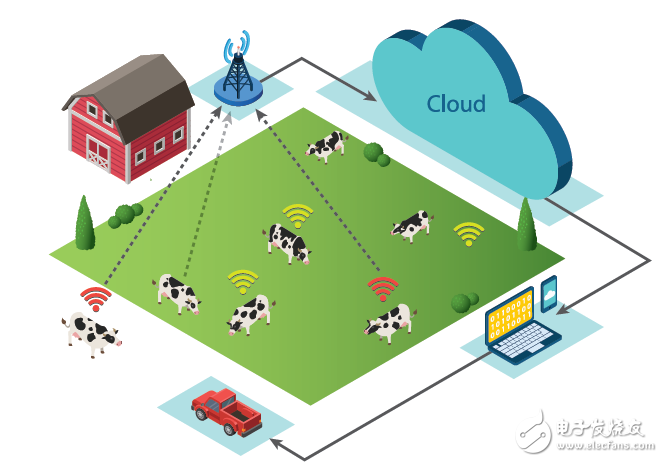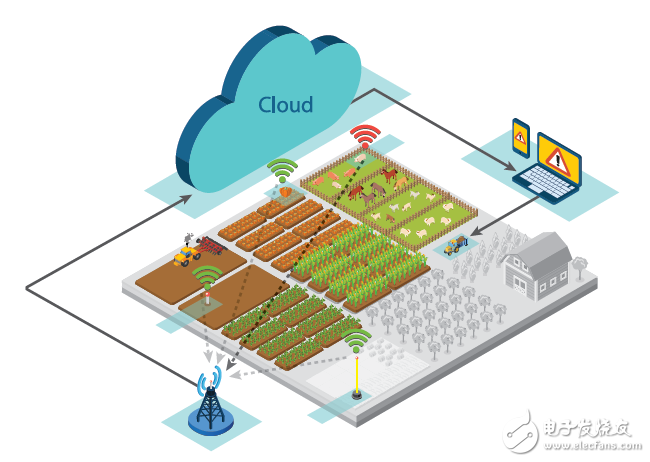The trend in smart agriculture is transforming intelligently, and Semtech's LoRa technology will revolutionize smart agriculture. It can track livestock and maximize crop yields.
Over the past century, we have witnessed extraordinary changes in the structure of the agricultural industry. Most of the micro-farms owned by the family have been replaced by large-scale large-scale farm operations, and the demand for food has steadily increased. According to the UN Food and Agriculture OrganizaTIon forecast, by 2050, the world needs to produce 70% more food than in 2006 to support the world's growing population. As production and operational demand continues to grow, agribusinesses are turning to the Internet of Things to achieve analytical technology and greater production capacity. Farmers and ranchers can no longer rely on visual cues or other passive and history-based indicators to manage their businesses. They must create more efficient operational solutions to regularly collect information, quickly synthesize data, and make informed business choices in the field to benefit from precision agriculture and real-time monitoring of the livestock industry.
The Internet of Things is bound to push the future of agribusiness to a new level. In some countries, smart agriculture is becoming more and more popular, but in order to accelerate the global deployment of IoT technology, farmers and ranchers need low-cost, low-power sensors. Semtech's LoRa® devices and wireless RF technology (LoRa technology) and LoRaWANTM open protocol are ideal for sensors; these sensors only need to update information several times per hour because the environment does not change dramatically. In addition, because many farms and ranches are in rural areas and do not have access to cellular networks or licensed bands, they need an easy way to install network infrastructure for their IoT applications.
By using LoRa technology and the LoRaWAN open protocol, agribusiness can digitally monitor, manage and analyze all aspects of its business to improve its overall operations and return on investment (ROI). From tracking the health of livestock to monitoring pregnant cows to increasing crop yields, LoRa technology provides a solid platform for the future of smart agriculture because it is easy to deploy and helps farmers and ranchers Develop its business.
Trends in smart agricultureWhat if only half of the fields need more fertilizer and do not get enough water? If one of the 100 cows is sick, you need to know which cow should be isolated to stop the spread of the disease. What should I do? What if you need to monitor a cow that is ovulating to ensure that the mother is healthy throughout the breeding process?
The competitive state of the agricultural business has driven farmers to find a technological advantage. Whether using GPS-driven autopilot tractors or dual-season soybeans to increase production, farmers are always paying close attention to a new generation of innovative agricultural technologies. The future of agriculture is one of real-time data monitoring, in-situ sensing equipment and long-term data analysis.
LoRa-enabled devices can handle many of the things that happen in smart agriculture, from tracking cattle roaming in huge pastures to monitoring soil moisture. Compared to other agricultural IoT devices, LoRa-based technology provides longer battery life and longer distance data transmission at an affordable price point.
QuanTIfied Ag is the developer of livestock health management labels and software that uses LoRa technology to remotely track and monitor sick and pregnant cows at different stages. While WaterBit provides farmers with real-time and low-cost sensing systems to improve crop quality and yield, the company uses LoRa-based devices to closely monitor soil moisture in large agribusiness farms.
LoRa technology simplifies and improves the day-to-day operations of every smart agricultural application. This technology has become extremely valuable for agribusinesses as they are able to adapt to the changing needs of the agricultural industry.
“In livestock farms, power consumption is really important. Livestock are reluctant to remove their electronic tags from their ears to achieve their charging goals, so when they roam in the ranch, battery life must last at least 8 months. With the low power consumption of LoRa technology, we have seen the ear tag has been running for more than a year and helped monitor sick cows or pregnant cows,†said Vishal Singh, CEO and founder of QuanTIfied Ag.
Livestock trackingMonitoring a group of cattle is an all-weather job because livestock farms can lose billions of dollars each year due to diseased cattle. So while ranchers continue to focus on their financial growth, they need a technology to enhance and simplify their operations.
QuanTIfied Ag, based in Lincoln, Nebraska, has developed a cattle electronic tag that integrates LoRa technology to measure bovine body temperature, head movement and overall movement. All data is collected into an application server to look for "outliers". For example, a cow's data shows that its movement is reduced and body temperature is reduced, and the data becomes an indication of the disease. Quantified Ag's solution provides a mobile app that notifies farmers about potential health issues. So they can check the cow and then have a remote video conference with the veterinarian who can check the animal's vital signs and collect biometric data. This allows farmers to quickly pay attention to their animals in a timely manner to try to stop the spread of disease throughout the herd.
There are now many LoRa-based IoT devices designed specifically for livestock management applications that are coming to market. Another device currently being tested and designed can be fed to cows and used for animal monitoring. This LoRa-based sensor monitors body temperature and sends the cow's ovulation signal to an artificial insemination veterinarian. This approach saves working time and reduces guesswork by letting the farmer know exactly what is happening in each potential cow mother's body.

LoRa-based cattle tracking system
Maximize crop yieldsToday's farmers are eager to get data that enables them to make accurate decisions about irrigation and fertilization, enabling them to optimize their crop yields. Moisture and soil are the main factors that increase crop yields while everything else remains the same. Once a farmer has control over water and soil, he or she can maximize crop yields within the limits of weather and crops.
WaterBit, Inc., funded by the National Science Foundation (NSF) in Silicon Valley, USA, provides farmers with a highly refined, real-time, low-cost sensing system that is optimized for optimal use of resources. The quality and yield of crops.
The company's irrigation sensors use LoRa technology and the LoRaWAN open protocol to connect devices to the gateway. To meet the basic needs of irrigation and fertilization, the WaterBit system provides two-way communication for end nodes, allowing them to read sensor data and implement control functions. These sensors detect the water level, the iron content of the soil and the salt content. As a result of the measurement, farmers can optimize their operations by knowing the rich data to better manage their crops and ensure the highest crop yields.
WaterBit's LoRa-based nodes have been installed in many different types of crop fields in California's Central Valley, including corn, cotton, strawberries, almonds and vines, supporting 24/7 operations. Designed for ultra-low power consumption, these sensors consume only 13 joules of energy per day when deployed to dense forests up to 3 miles from the gateway. This ultra-low power design eliminates the need for battery replacement and results in a zero-maintenance product that can be successfully installed in minutes, creating an unparalleled achievement that is generating significant customer interest.
“By using LoRa technology, our customers are managing the moisture in the soil with higher precision, and for grape crops, farmers can increase production by 20% and 30%.†Manu, founder of WaterBit, Inc. Pillai said.

LoRa-based precision farm system
LoRa technology for smart farming has the following key benefits:
Positioning: LoRa technology uses a GPS-free positioning technology that does not require additional power consumption.
Low connection costs: LoRa technology operates in the unlicensed ISM band, which means that the spectrum cost is zero or very low (if using an external service provider, a very low connection cost may be required).
Open standards: The LoRaWAN open specification is supported and maintained by the LoRa Alliance, supporting seamless connectivity and convenient scalability.
Now available: Now available for implementation and widespread deployment of public and private networks.
Utilizing deployed assets: LoRa technology's robust and reliable signal transmission can cover a wide range, even in rural areas.
Growing ecosystem: The fast-growing LoRa Alliance currently has more than 500 member companies that are using LoRaWAN open specifications to create solutions. The LoRa Alliance includes key industry members and many other types of startups and network operators. When they are combined, the ecosystem provides multiple sources of supply, from communication chips to networks to server-based application platforms. The LoRa Alliance also certifies sensors and other devices to support interoperability.
Security: Built-in AES-128 encryption technology to support secure data transmission in rural areas.
to sum upThe future of smart agriculture is to achieve maximum efficiency by collecting and analyzing data. For rapid adoption in agribusiness, the solution must provide long-range, low-power, easy-to-deploy, and low-cost features. By using LoRa technology and the LoRaWAN open protocol, farmers and ranchers can maximize their efficiency and focus more on their business growth and profitability.
D-sub Connector Contacts
A D-sub connector is a form of connector commonly found in electronic and computer systems. It consists of a D shaped metal band and two or more parallel rows of either pin contacts (male) or socket contacts (female). D-sub connector contacts can vary in size, material, current rating, length and resistance.
The most common type of connector is the crimp contact. These are assembled by inserting a stripped wire end into the cavity at the rear of the contact. The cavity is then crushed using a crimp tool, gripping the contact to the wire.
What are D-sub connector contacts used for?
The D-sub connector contacts carry the signal from the source to the destination across the D–sub connection.
Types of D-sub connector contacts
Most D-sub connectors are supplied with contacts ready in place. Contacts can be replaced if damaged or if the application of the D-sub connector is to be changed from the original design specification.
High-current, high-voltage, or co-axial inserts require larger contacts. The material of the D-sub connector contact can be changed if the robustness or quality of the connection needs to be improved.
D-SUB coaxial contact,D-Sub Connectors Contacts,D-Sub Plug Connectors Contact,D-Sub Receptacle Connectors Contact
ShenZhen Antenk Electronics Co,Ltd , https://www.antenkcon.com
